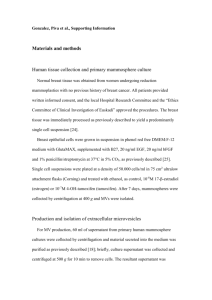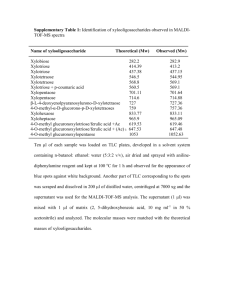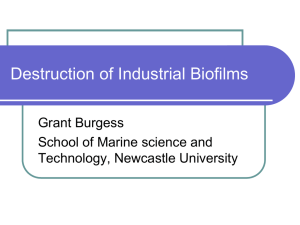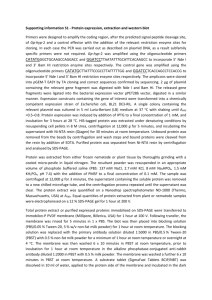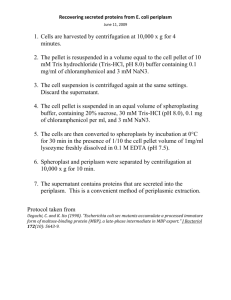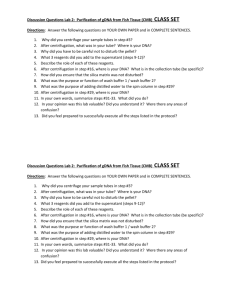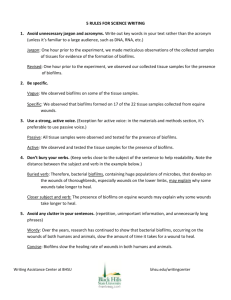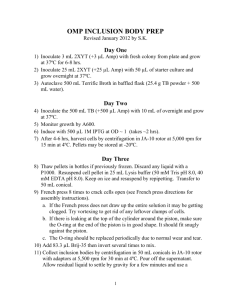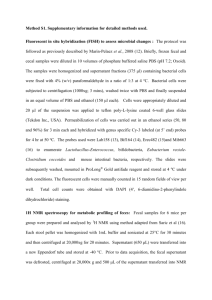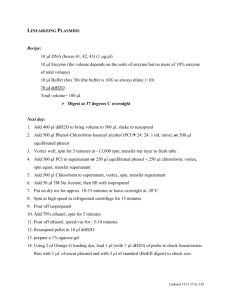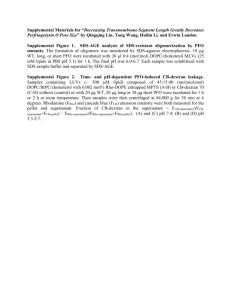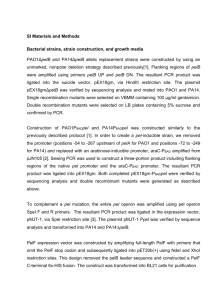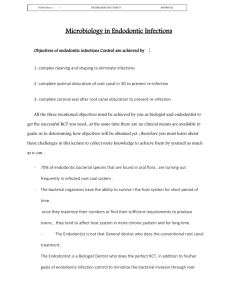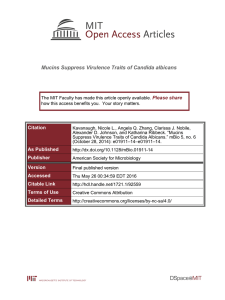Supplementary Information (doc 41K)
advertisement
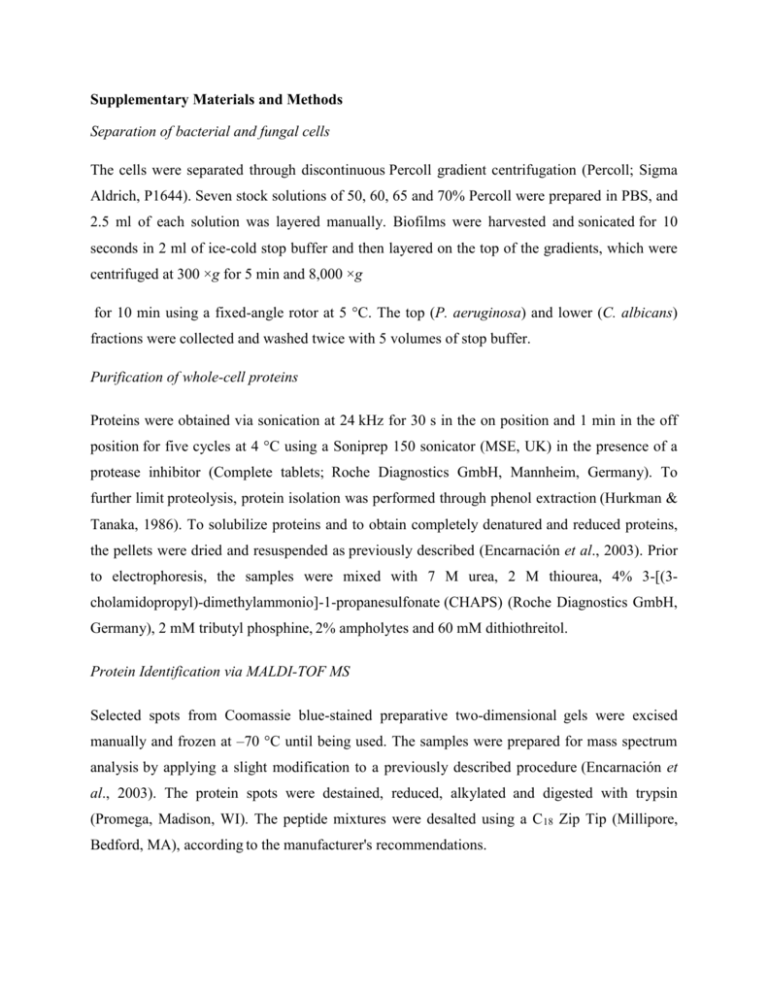
Supplementary Materials and Methods Separation of bacterial and fungal cells The cells were separated through discontinuous Percoll gradient centrifugation (Percoll; Sigma Aldrich, P1644). Seven stock solutions of 50, 60, 65 and 70% Percoll were prepared in PBS, and 2.5 ml of each solution was layered manually. Biofilms were harvested and sonicated for 10 seconds in 2 ml of ice-cold stop buffer and then layered on the top of the gradients, which were centrifuged at 300 ×g for 5 min and 8,000 ×g for 10 min using a fixed-angle rotor at 5 °C. The top (P. aeruginosa) and lower (C. albicans) fractions were collected and washed twice with 5 volumes of stop buffer. Purification of whole-cell proteins Proteins were obtained via sonication at 24 kHz for 30 s in the on position and 1 min in the off position for five cycles at 4 °C using a Soniprep 150 sonicator (MSE, UK) in the presence of a protease inhibitor (Complete tablets; Roche Diagnostics GmbH, Mannheim, Germany). To further limit proteolysis, protein isolation was performed through phenol extraction (Hurkman & Tanaka, 1986). To solubilize proteins and to obtain completely denatured and reduced proteins, the pellets were dried and resuspended as previously described (Encarnación et al., 2003). Prior to electrophoresis, the samples were mixed with 7 M urea, 2 M thiourea, 4% 3-[(3cholamidopropyl)-dimethylammonio]-1-propanesulfonate (CHAPS) (Roche Diagnostics GmbH, Germany), 2 mM tributyl phosphine, 2% ampholytes and 60 mM dithiothreitol. Protein Identification via MALDI-TOF MS Selected spots from Coomassie blue-stained preparative two-dimensional gels were excised manually and frozen at –70 °C until being used. The samples were prepared for mass spectrum analysis by applying a slight modification to a previously described procedure (Encarnación et al., 2003). The protein spots were destained, reduced, alkylated and digested with trypsin (Promega, Madison, WI). The peptide mixtures were desalted using a C 18 Zip Tip (Millipore, Bedford, MA), according to the manufacturer's recommendations. Mass spectra were obtained using a MALDI-TOF mass spectrometer autoflex™ (Bruker Daltonics, Billerica, MA) operated in delayed extraction and reflectron mode. The spectra were externally calibrated using a peptide calibration standard (Bruker Daltonics 206095). Peptide mixtures were analyzed using a saturated solution of alpha-cyano-4-hydroxycinnamic acid in 50% acetonitrile-0.1% trifluoroacetic acid. The resulting monoisotopic list of m/z values was submitted to the search engine MASCOT (Perkins et al., 1999), searching all protein and DNA sequence information available from public databases (Swiss-Prot and NCBInr). The following search parameters were applied: mass accuracy, ± 0.35 Da; fixed modification, carbamidomethylation; variable modification, methionine oxidation; and a maximum of one tryptic missed cleavage. A protein was considered to be identified if the scores from the database searches clearly exceeded the algorithm's significance threshold (P<0.05). Detection and quantification of metabolites Detection of AHLs was conducted following the methodology of Shau et al. (1997), with slight modifications (Supplementary Information). For pyoverdine quantification, cells were removed via centrifugation, and the absorbance of the supernatant at 405 nm was determined (Hohnadel et al., 1986). The concentrations were calculated based on the absorbance values for purified standards (Pyoverdines, Cat. No. P8124, Sigma-Aldrich) dissolved in RPMI medium. The obtained A405 value was divided by the OD600 of the culture to indicate the amount of pyoverdine produced per cell. Rhamnolipids were extracted from the supernatant and detected via TLC as previously described (Caiazza et al., 2005). The TLC plate was scanned with a GS-800 imaging densitometer (BioRad), and fold changes in spot intensity were determined with PDQuest 2-D Analysis software (Bio-Rad). The concentration of D-glucose in the culture supernatant was determined through an enzymatic assay using a D-glucose test kit (Cat. No. 10 716 251 035, R-BIOPHARM, ROCHE). Pyocyanin was extracted, and the concentration in the culture supernatant was determined via HPLC. At the specified time points, the supernatant was removed and passed through a 0.22-μm filter. Then, a 5 ml aliquot of the cleared supernatant was mixed with 2.5 ml of chloroform, and the samples were vortexed for 30 s and centrifuged for 2 min, after which 1 ml of the lower chloroform layer was removed. A second extraction of the same 5 ml aliquot was performed, and the chloroform layer was collected and combined with the first extract. The extracts were resuspended in 50 μl of methanol, and the pyocyanin concentration was determined through HPLC analysis in a Waters Symmetry C18 reverse-phase column. The solvent system consisted of 0.05% trifluoroacetic acid (TFA) in water and 0.05% TFA in acetonitrile, and 25 to 30 min runs were conducted. Calculations were performed based on absorbance values for purified standards (Pyocyanin, Cat. No. P0046, Sigma-Aldrich). Confocal laser scanning microscopy The biofilms formed on polystyrene slides were analyzed via confocal laser scanning microscopy. The slides were constructed from polystyrene plates, sterilized for 30 minutes with ultraviolet light and immersed in Petri plates under culture conditions identical to those described for obtaining biofilms for proteome analysis. Following biofilm formation, the slides were removed and transferred to 50-ml conical tubes and washed once with fresh medium. To monitor the viability of cells, biofilms were stained using the BacLight LIVE/DEAD staining system according to the manufacturer’s protocol (#L7007, Molecular Probes). The biofilms were stained for 30 minutes, washed once with fresh medium and observed with a Zeiss LSM 510 META confocal laser scanning microscope equipped with 488-nm, 514-nm, 543-nm and 633-nm laser lines. Enzymatic assay for catalase activity A standard enzymatic assay (Hassett et al., 1999) was used to measure total catalase levels for C. albicans and P. aeruginosa. Cells were disrupted via sonication in potassium phosphate buffer, followed by centrifugation to obtain cell extracts. A total of 40 µg of protein was used in the assays, and the recorded enzymatic activity was standardized for protein contents. Iron and oxygen quantitation The concentration of iron ions in the culture supernatant was determined separately for Fe2+ and Fe3+ through spectrophotometric assays using iron test kits (Merck). The concentration of dissolved oxygen in the culture was determined using an OXEL-1 oxygen electrode (WPI). Determination of mutation frequencies associated with resistance to antibiotics and fungicides After 24 hours of cultivation, single-species biofilms and mixed biofilms were scraped from the culture plates and disaggregated in 20 ml of Tween solution (10 mM MgSO4 and 20 mM Tween 20). Then, 1 ml of the biofilm suspension was inoculated into 10 ml of LB medium to recover the bacterium or into 10 ml of YPD (10 µg/ml chloramphenicol was used to reduce the growth of bacteria) medium to recover the fungus. The cultures were incubated for 12 hours at 37 °C and shaken at 250 rpm. As appropriate, the cultures were concentrated via centrifugation to facilitate the recovery of resistant mutants. Aliquots were diluted in Tween solution, disaggregated by vortexing for 60 seconds to obtain maximum dispersion and plated onto LB selection plates containing antibiotics to recover resistant bacteria. Amphotericin-resistant C. albicans cells were selected on YPD (20 µg/ml Amphotericin B) plates. Colony counts were performed after 48 h of incubation at 37 °C. Mutation frequencies were expressed as the number of antibiotic-resistant mutants recovered as a fraction of the viable count. DNA sequence analysis of RifR mutants. A single colony from each RifR mutants (Supplementary Table S4) was suspended in 50 μL H2O and the cells were lysed by boiling for 10 min. To identify responsible RifR mutations, the region of rpoB (β-subunit of RNA polymerase) corresponding to Rif clusters I, II, and III was amplified by PCR using primers PAO1rpoB1 (5′-TCATCGATGTGCTCAAGACC-3′) (Jatsenko et al., 2010) and PAO1rpoB3 (5′-GACCGAGTCGATCACACC-3′) (Weigand & Sundin, 2012). PCR products were purified using the QIAquick PCR Purification kit. The primers PAOrpoB1 and PAO1rpoB3 were employed for the sequencing of PCR products. Mouse model of P. aeruginosa-C. albicans co-infection Nu/Nu mice (20–22 gr) were purchased from the vivarium of the Institute of Biotechnology, University of México. The mice were housed in filtered cages under specific pathogen conditions and permitted unlimited access to food and water. Prior to animal experiments, P. aeruginosa PAO1 and C. albicans CAI-4 were grown for 14 hours to the exponential phase. Next, the cells were pelleted via centrifugation, washed twice with sterile PBS, and the optical density of the cell suspension was adjusted based on spectrophotometry at 600 nm. Mice were inoculated intraperitoneally with each desired dose, which was suspended in 0.2 ml of PBS buffer and mixed immediately before injection. After infection, mortality was monitored over 2 weeks.
